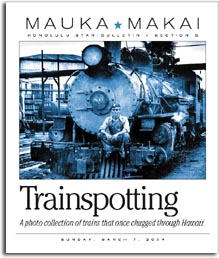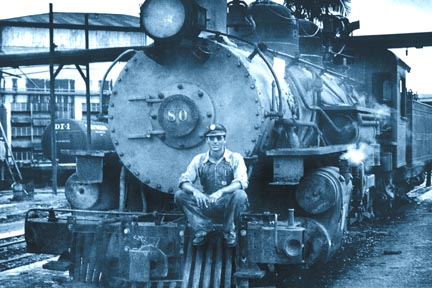
[ MAUKA MAKAI ]
VICTOR NORTON COLLECTION
The 15-stall Iwilei roundhouse stood full on a Sunday after the war ended, when operations came to a halt. The roundhouse, built in 1908, stood until 1959.
Railway album
A Navy man’s photo hobby
becomes the only record of
Hawaii trains during the war
It wasn't easy shooting photographs in the islands during World War II, particularly if you were a serviceman. Loaded cameras weren't allowed on base, and camera clubs dried up. Film was scarce. Taking pictures of anything scenic ran the risk of accidentally including something sensitive or top-secret, and because the islands were one big staging area, that happened all the time. Transportation was particularly off-limits.
All of which must have been frustrating for Machinist's Mate Victor Norton, hailing from rural New York and assigned to the ship-repair facility at Pearl Harbor. A railroad buff, he had the hobbyist's disease known as "trainspotting," a desire to see and catalog every locomotive in the region. He began spending his off-duty hours hanging around the Iwilei roundhouse of the Oahu Railway and Land Co., taking snapshots on a 127-film camera and developing the negatives off-base.
Hawaiian Railway Society
Located at the end of Renton Road in Ewa: Take H-1 west, exit on 5A Ewa. Stay on Highway 76 south for 2.5 miles. Turn right at Tesoro Gas Station, continue for 1.5 miles. Turn left onto small lane with cul-de-sac. Entrance to the Society grounds will be on your right, through the chain link fence. Open 11:30 a.m. to 4:30 p.m. Sundays. Information: 681-5461.
But Norton was dissatisfied with the small, grainy images and had his parents send him his "press" camera, one that shot large-format 4-1/2 by 3-1/2-inch negatives to capture every grimy detail of the OR&L locos, and more importantly, had a detachable film back so the camera could be carried safely on and off base without compromising security. Dressed in his navy whites, Norton was never hassled around the trainyard, and he became a familiar fixture to the train crews.
The war ramped up the need for tracked transportation, and every GI stationed here has memories of the network that circled each island. Trains hauled sugar, soldiers, supplies, pineapples, aircraft and everything else, and were often the only way to travel into Honolulu from faraway bases like Wheeler. But when the war ended, so did gas-rationing, and a new road system was created. The rise of the automobile meant the need for trains evaporated. The last passenger train ran in 1947.
VICTOR NORTON COLLECTION
Four locomotives coupled together pulled out of the Iwilei train yard on Dec. 7, 1945, headed for a parade honoring Fleet Adm. Chester Nimitz. As the admiral passsed, the four locomotives let loose a deafening four-whistle salute.
Stationed at Pearl Harbor from 1943 to 1946, Norton captured the last glory days of the OR&L in exhausting detail. Then, he packed up his collection and returned home, and boxes of negatives went into storage.
But unlike many other irreplaceable images moldering in the nation's attics, these pictures have been resurrected in a new book.
Norton's pictures are given superb reproduction in "Hawaiian Railway Album -- WWII Photographs," the first of a projected three-volume set of classic Hawaiian railway images. The book's author is Gale E. Treiber of the Hawaiian Railway Society, another sailor stationed in the islands who was fascinated by trains, and the images literally fell into his hands.
"I was stationed at CINCPAC and volunteered at the Society out in Ewa in the late '80s," said Treiber. "Then I moved to Erie and worked for General Electric for 11 years, making trains. I decided to move back out to Hawaii, and the night before I left, the local railroad buffs gave me a going-away party.
"They were all giving me a hard time about moving to a place where there aren't any trains. 'No!' I said. 'There were lots of trains in the islands, particularly during the war.' But no one believed me. Then an old gent who was there spoke up and said, Gale's right, Hawaii had lots of trains. I was there and I photographed them.'"
VICTOR NORTON COLLECTION
Victor Norton Jr., the photographer, posed on the pilot of Oahu Railway and Land Co. locomotive No. 88, in Haleiwa in late 1945. No. 88 was the company's first excursion train after the war. The shot was likely taken by a Navy buddy using Norton's camera.
THE OLDER MAN, you've figured out by now, was Norton, and the group quieted down as he spun clickety-clack reminiscences about the OR&L and sugar-train systems. Treiber asked him if he really had pictures. "Hundreds," said Norton. "If you want them, you can have them. No one's asked me about them in 50 years."
Treiber accepted on behalf of the Hawaiian Railway Society and also urged Norton to donate any mainland train pictures he has to mainland train-history societies for preservation.
"Bob Paoa, our historian emeritus, speculated that there are likely attics all across the country filled with history that might be thrown away," said Treiber. "Such collections really should be shared with history groups, and fellows who are getting older should make it clear to their relatives what should be done with their collections after they pass on."
Treiber credits Colorprints with making excellent prints of Norton's original negatives. "The interesting areas of a train are often the running gear underneath, and often those parts are in shadow," said Treiber. "Colorprints really brought those areas out."
The book was published by the Railroad Press of Pennsylvania, and is enjoying brisk sales at train museums and hobby shops, reports Treiber. "In one hobby shop, all copies were gone in two hours."
Treiber donated the publishers' advance to the Railway Society, and at this point, the only place you can buy the book is at the HRS gift shop in Ewa. "Already, we've had to order more," said Treiber.
VICTOR NORTON COLLECTION
Kids check out the locomotive during a Sunday ride at the Hawaiian Railway Society in Ewa.
VICTOR NORTON COLLECTION
ON THE COVER: The portrait of engineer George Cabral with his locomotive, taken in 1926, is part of “Hawaiian Railway Album WWII Photographs.”
Click for online
calendars and events.






